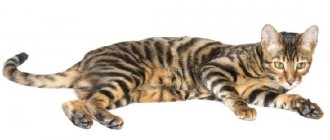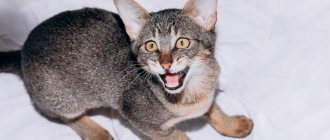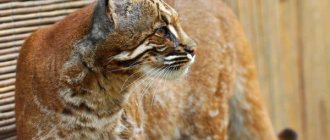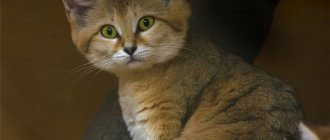Origin story
In the Irish Sea, exactly between the ports of Belfast and Liverpool, is the Isle of Man. It is famous not only for the megalithic complex “Castle on Heights”, but also for its tailless cats. Let us, however, make a clarification: not all Manx cats are completely devoid of such an important attribute. Some retain several vertebrae, and in some individuals the host has the length we are accustomed to.
The reason for this feature lies in a banal genetic anomaly - the isolation of the island and the lack of “new blood”, which ultimately led to connections between relatives. The result is a hole or a funny stump instead of a tail in the descendants.
The first exhibition was held in 1871 in England, and 30 years later a club for Manx cat lovers was organized there. The standard appeared a little later: in 1903.
Gradually, Manx cats began to spread throughout the globe: the first registration took place after the appearance of the breed in America. In Europe, Manx were not considered a separate species for a long time: precisely because of a genetic mutation, they were classified as a defective type and they insisted that breeding was simply dangerous for new generations. But the popularity of cats eventually broke even the most steadfast. Today, almost all major world felinological organizations have recognized them, and the CFA Association has classified them as Cymrics, considering them to be of the same type.
They are still arguing about their ancestors: they could have been British shorthair cats (they have many common features), but one thing is certain: the first cats were brought there by settlers, took root and began to actively reproduce.
Purchasing a Manx kitten
Manx are extraordinary and attractive animals, which contributes to their popularity throughout the world. Problems with breeding offspring make it difficult to acquire them even in Europe and America, despite the fact that there are nurseries for breeding Manx cats abroad. There are no registered nurseries in Russia. There can only be offers for sale from private owners. In any case, you must pre-book the purchase of a kitten.
The price of a small Manx largely depends on its class: whether it is a Rumpy, Rumpy Rysler, Stumpy or Longy, as not all classes are eligible for show. The price is also influenced by the pedigree of the parents and whether they have championship titles. When purchasing abroad, the cost of the kitten will include shipping costs.
Kittens with docked tails can be adopted into a new home after three months, as they are not prone to the characteristic diseases of the breed. In other cases, Manx cats are purchased at the age of four months or older to ensure the health of the animal.
The minimum price for a Manx kitten is four hundred and fifty dollars. If you are planning to buy a champion-level baby, be guided by the cost several times more.
When making a deal, carefully study the pedigree of the future pet, since the recessive tailless gene affects the health of the offspring and mating of a rampie with a rampie, which can lead to hidden genetic diseases, is not recommended. Remember that not all tailless cats are Manx. This breed has a characteristic build and a jumping gait.
Pay attention to the baby's appearance: he should look healthy (clean eyes, ears, anus, no scratches on the skin or bald spots) and active. Observe how he moves - whether there are any difficulties when walking and signs of dystrophy of the hind limbs.
The body type of these kittens corresponds to the Manx breed
When completing a transaction, you should receive a package of documents:
- contract of sale;
- kitten's passport indicating its name, date of birth and pedigree;
- certificate of primary vaccination.
Video: Manx is a breed of cats that does not have a tail (a Manx breeder talks about some of the features of the breed)
Standards
Manx weigh little: males weigh a maximum of 5 kg, females - 3.5-4 kg.
| Standard | Description |
| Head | Round, small, chubby cheeks. The ears are erect, with rounded tips. Both inside and outside are abundantly pubescent. The cheekbones are wide and prominently protruding. |
| Eyes | Larger, wide open, set slightly askew. The iris can be any color, but matching the color is highly valued. |
| Frame | Rectangular, elongated, massive, with strong bones. The hind legs are longer than the front legs, the front legs are short and strong, which is why the cat’s sacrum is noticeably raised. The chest is wide, the back is arched. Short and massive neck. The paws are round and elastic. |
| Wool | Thick and plush to the touch. There is a dense undercoat. The Manx's fur feels like a rabbit's skin. |
There are 4 types of tails:
- Rumpy: there are no tail vertebrae at all, and in the place where the tail is located in other cats there is a fossa. Such cats are rated higher than others at exhibition events.
- Rampy riser: there are 1, 2 or 3 vertebrae. They are allowed to participate in exhibition events, but only if the cat passes a kind of test: a specialist pets the animal and, if the vertical tail does not interfere with the hand, the cat is considered admitted.
- Stampi (stampi): from 5 to 14 fused vertebrae (lumpy or in tension).
- Longi: The tail of this species is of standard length. Many owners stop it in kittens: this helps prevent ossification of the vertebrae in old age.
Manxes, unfortunately, are a rare breed and it is difficult to find a cattery. And not only in our country, but also in neighboring countries. Most of them are concentrated in the United States, but there are a few in Europe. Therefore, acquiring a Manx is a difficult and expensive task. The approximate price tag is from $450 and above. The cost consists of several factors: it is not only the geographical location of the seller, but also the class, the merits of the parents, whether the animal is purchased for breeding or for oneself. To purchase a show-class Manx, you must make a reservation in advance.
Disqualifying signs:
- No slanted eyes;
- Triangular head;
- Excessively elongated torso.
Health
Unfortunately, the gene responsible for the absence of a tail can also be fatal. Kittens that inherit copies of the gene from both parents die before birth and dissolve in the womb.
Since the number of such kittens is up to 25% of the litter, usually few of them are born, two to three kittens.
But even those Cymrics who have inherited one copy can suffer from a disease called Manx Syndrome. The fact is that the gene affects not only the tail, but also the spine, making it shorter, affecting nerves and internal organs. These lesions are so severe that kittens with this syndrome are euthanized.
But, not every kitten will inherit this syndrome, and its occurrence does not mean bad heredity. Kittens with such lesions can appear in any litter; this is simply a side effect of being tailless.
Usually the disease manifests itself in the first month of life, but sometimes it can drag on until the sixth month. Buy from nurseries that can guarantee you the kitten’s health in writing.
Character and behavior
Reviews about these cats are the most positive. They are friendly and intelligent, and feel comfortable both in a large, noisy family and in a small one-person family. They love attention very much, but do not demand it, and are excellent at entertaining themselves. They are active, love to run and jump, so you should equip a special cat corner in which your pet can climb as much as he likes.
Manx treat people with great sympathy, both acquaintances and strangers. They are not afraid of guests and are the first to come up to introduce themselves, and at first they behave more than restrained, but when they get used to it, they allow themselves to be naughty, like kittens.
Children are not offended: we are ready to entertain them from morning until evening. They get along well in the same apartment with dogs (even large ones) and cats, but only if the neighbors behave calmly and do not show aggression. Manxes also know how to stand up for themselves.
They are obedient, quickly grasp information on the fly, and rarely allow themselves to be capricious about food or filler. They love to look at water flowing from a tap or shower. Some individuals even manage to open the taps for this!
They are excellent fishermen and hunters, so choose who will live in the same house with you: either Manx, or fish and decorative rats.
After running and jumping, they can rest for a long time, sitting on the windowsill and looking with interest at the world behind the glass. If you open windows for ventilation, install special strong nets on them in advance so that your pet does not fall out.
Expert opinion
Dusheba Vera Ivanovna
In 2010, she graduated from the Moscow State Academy of Veterinary Medicine named after K.I. Scriabin with honors, specializing in veterinary medicine. I regularly attend veterinary conferences, congresses, and webinars.
Do not allow your pet to climb onto high cabinets: the lack of a tail prevents them from grouping properly when doing so, and the cat can be seriously injured.
Since Manx cats have fur that grows very close to the anus (and there is no tail), the remains of excrement often stick to it. Therefore, you will have to look under the cat’s tail every day, and, if necessary, clean contaminated areas.
Mating
If you do not want to breed Manx cats, then the best options would be castration or sterilization, which is carried out as early as six months. But if you are planning to breed cats, then remember that they will be ready to reproduce quite early. Females begin estrus as early as 4 months, males are ready to become dads at 5-7 months, by the age of one and a half years, and all cats already have offspring.
But remember that Manx cats are different from other cats because they continue to grow until they are 4-5 years old.
Care instructions
Human care products - shampoos, toothpastes, gels, etc. - are designed exclusively for humans and are not suitable for animals. The components included in their composition can cause not only banal skin dermatitis, which takes a long time and is difficult to treat, but also intestinal upset and even poisoning. Therefore, buy care products only in pet stores. You don’t have to grab the most expensive ones - and the cheap ones do their job perfectly.
Wool
Thick fur requires regular grooming. During the shedding period, the cat needs to be brushed daily, the rest of the time - 1-2 times a week. To do this, you will need a fine-toothed metal comb, a comb with natural bristles and a furminator. It is better not to untangle the resulting tangles (this causes severe discomfort to the animal), but to cut them off with nail scissors.
Does your cat like to swim?
Not really
Eyes
The eyes are washed daily by soaking a cotton pad in strong tea leaves, fresh chamomile infusion or clean boiled water.
Ears
The ears are examined every week. If dirt and wax have accumulated in them, wipe it off with a cotton pad soaked in ear lotion. You cannot pour anything inside, nor use aggressive products (with alcohol, dyes and fragrances).
Teeth
Brush your teeth 2-3 times a week using cat toothpaste and a baby toothbrush with trimmed bristles.
Attachment to family.
Very affectionate cats. They express their feelings towards the owner and his family members by loud purring and a desire to constantly be near people. At the same time, there is no intrusiveness. If Manx was drawn to affection, but people did not want to pet him, then the cat will not impose himself. A playful and active animal. At a young age they are able to run and play pranks for hours. As they get older, they lose their former fervor, but they will never refuse to play.
Photos of Manx cats:
Catering
How to feed the animal - the owner must decide in the first weeks of the kitten's appearance in the house, since jumping back and forth will not benefit the animal, and feeding it either natural food or ready-made food is completely harmful. Manx are not picky, and are easily accustomed to both the first and second options. If the breeder’s baby ate dry food, and you plan to prepare his food yourself, transfer the kitten to a new regime gradually.
When choosing a menu, remember a few rules:
- Adult animals are fed no more than 2 times a day (an exception is made for weakened animals, lactating and pregnant cats), kittens 4-6 months - 3-4 times a day, under 4 months - 5-6 times.
- Drinking water must be fresh. Change it 2 times a day. Tap water is not suitable: it may contain harmful compounds and components. Drinking water can be purified using a filter or settled. Cats should not be given tea, juices or herbal decoctions; the same applies to compotes, alcohol and alcohol-containing products.
Natural products
Natural feeding does not mean that the cat is suitable for food from your table. Most of the dishes are absolutely not suitable for animals. This applies to sweet, salty, sour, flour, fatty, spicy, smoked, canned. As you can see, the list is extensive.
In addition, Manx should not be given fatty meat (pork, goose, lamb), large bones and tripe, lard, river fish, raw eggs, dairy products with dyes, potatoes, tomatoes, fruits (except for apples and melons), flour, baking.
But lean meats, sea fish, porridge, stewed vegetables (zucchini, carrots, beets, pumpkin, asparagus, broccoli, green salad), raw chicken yolk, low-fat sour cream, yogurt and kefir can and should be given.
Be careful with cow's milk: some adult cats stop digesting lactose as they age. Porridge and meat are cooked in plain water, without salt and spices.
Recommended food
Holistic and super-premium food classes are made from much better quality products than premium and economy food classes. They cost more, of course, but the price tag is quite reasonable: they contain dehydrated meat, plenty of vegetables and berries, and only natural preservatives. Examples of high-quality food from the holistic group: Acana, PureLuxe, Wildcat; super-premium: Brit Care, Savarra, Vet Life. And be sure to pay attention to the markings: age, health status, activity level of the animal.
Below are recommended super-premium foods. Links with the names of the food are clickable, on them you can, within our website, get acquainted with the descriptions of the food and read reviews from owners of Manx cats.
| Holistic | Super premium | Super premium |
| Gather | Guabi Natural | Mealfeel |
In addition to food, you should choose the right vitamin and mineral supplement. Dry brewer's yeast can be purchased independently and given in courses, following the instructions. The rest should be purchased only after consultation with a veterinarian.
Interesting Facts
During the existence of the Manx tailless cat, many interesting things have been associated with it:
- There is a beautiful legend associated with bob-tailed cats. According to legend, it was this animal that was the last to run into Noah’s ark, and its tail was accidentally pinched. The cat chose to remain without this part of the body and go on a rescue voyage.
- Residents of the Isle of Man are proud of tailless cats and believe that they bring good luck. These animals have long been depicted on coins, paintings and jewelry.
- The museum in the capital of the Isle of Man contains a book dating from the 17th-18th centuries. – it contains a detailed description of cats of this breed.
Diseases
- Corneal dystrophy - this pathology occurs only in the Manx breed and is characterized by gradual clouding of the cornea of both eyes, turning into an ulcer. At the same time, the cat loses its appetite, has lacrimation and nasal discharge. Diagnosed at the age of 3-4 months. Treatment can be either medication or surgery. During treatment, cats need complete rest and isolation from people and animals.
- Pyoderma of the posterior part of the body is an inflammation of the skin with the release of pus. Reason: a consequence of advanced allergic dermatitis or infection in the wound. The fur begins to fall out, and blisters with purulent contents appear on the skin. The cat begins to scratch and lick the injury site and sleeps poorly. Untimely treatment can cause the formation of colloidal scars, decreased immunity, and sepsis. It is recommended to carefully cut off all the hair in the affected area, treat the skin with iodine solution, potassium permanganate or chlorhexidine, and lubricate it with antibacterial ointment (Bacitracin, Mupirocin, Baneocin).
- Concrescence (fusion of vertebrae) is one of the most serious diseases. Medicines help improve the quality of life.
- Spina bifida (congenital) is characterized by the following symptoms: back pain, hunched back, refusal to climb stairs or jump on chairs and sofas. Treatment depends on the severity of symptoms. In some cases, it is enough to provide the animal with rest; in more severe cases, surgery is indicated.
- Manx syndrome: with this pathology, the structure of the spinal column and brain stem is disrupted, problems arise with defecation and urination, coordination, and gait. Often a hernia appears, pinched nerve endings in the spine and fusion of the vertebrae.
A pair of tailless genes leads to the fact that the offspring often die. Therefore, experts recommend breeding one tailless and one tailed Manx.
Expert opinion
Dusheba Vera Ivanovna
In 2010, she graduated from the Moscow State Academy of Veterinary Medicine named after K.I. Scriabin with honors, specializing in veterinary medicine. I regularly attend veterinary conferences, congresses, and webinars.
If you notice that your pet's behavior has changed (for example, he began to sleep constantly or sleep little, he itches, refuses to eat, has difficulty walking) - take the cat to the veterinarian for an examination. Timely assistance can not only restore health, but also save lives!
Do not try to diagnose and cure your pet on your own, buying medications at the pharmacy at your own discretion. Some illnesses have similar symptoms, and if you miss the time, the situation will get much worse. Don’t forget about preventive vaccinations and deworming: even if your cat is completely domestic and has only seen the street from the window. A number of dangerous pathogens can enter the house on human shoes, clothes and hands (if you do not wash your hands first, but pet the cat, you should know - this is a bad habit), with food or water.
What diseases are typical for Manx cats?
Like all domestic cats, Manx cats are susceptible to a number of feline diseases. To keep your pet healthy, you must follow the following preventive rules:
- adhere to a balanced diet;
- carry out the necessary revaccination on time;
- monitor the animal’s teeth and oral cavity;
- get rid of fleas and ticks in a timely manner;
- Carry out deworming at least twice a year, even if your pet does not leave the apartment.
But besides this, Manx cats are prone to diseases associated with the characteristics of their breed. No tail means a shorter spine; Pathologies caused by this body structure can manifest themselves in the form of the following diseases:
- Manx syndrome: The kitten's spine grows too slowly compared to its body. Usually such kittens live no longer than four months.
- Congenital spina bifida, which leads to various neurological disorders of the cat’s body.
- Dystrophy of the hip joint, which is a pathology of the hind limbs of the animal.
- Various bladder and bowel dysfunctions.
- Corneal dystrophy. This disease is genetic. As a treatment, it is recommended to remove the dystrophy zone. If the disease is detected, such animals are not allowed to breed, but it does not affect the general health.
Most congenital diseases are detected in the early stages and such kittens are discarded. Adult animals have good immunity to colds and get sick infrequently. The average lifespan of a Manx is fourteen years.
Even a completely healthy cat needs a preventive examination by a veterinarian.
Animals are disqualified from participating in exhibitions in the following cases:
- poor physical condition, including runny nose and sneezing;
- weak hind limbs;
- when examining the profile, a stop or bend in the nose is evident;
- not slanted eyes;
- lack of toes (oligodactyly), fusion of toes (syndactyly) or excess (polydactyly);
- the presence of external parasites (the absence of internal ones is documented).
Only Rumpy and Rumpy Rysler take part in the exhibitions (provided that if you run your hand along the spine of such an animal, you will not feel the tail).










